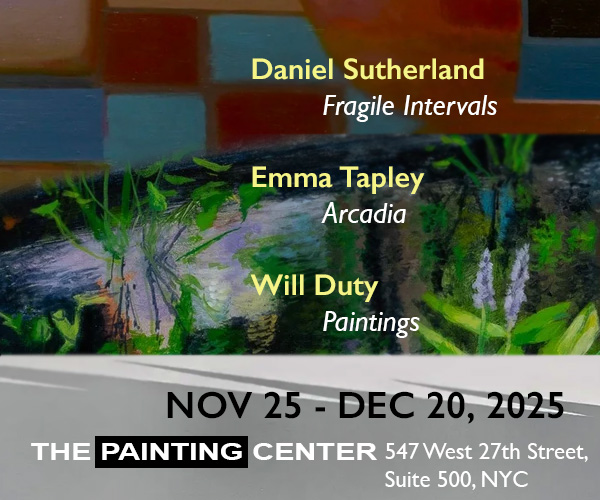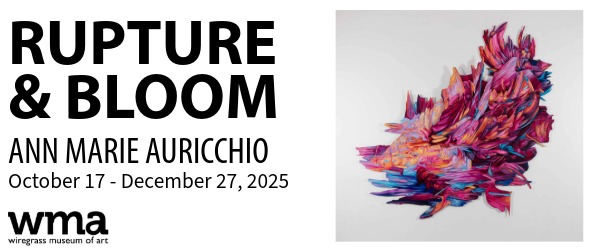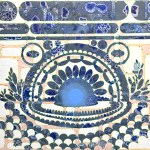
Over 13 years ago, Two Coats of Paint discovered Elizabeth Gourlay’s abstract paintings in Chester, Connecticut. “Her paintings speak of science as they document experiments with Cartesian planes and bar graphs,” the 2009 post notes. “They speak of music as shapes represent sound and colors represent volume. They also speak of history and culture through overlapping layers of seemingly worn or tattered paper, unraveling threads of ancient textiles, and scattered symbolic imagery juxtaposed with timeless patterns.” Owing to deeply rooted influences, her newer work retains some of these qualities, but it has also evolved. On the occasion of her outstanding solo exhibition of paintings and collages at the New Britain Museum of American Art, Two Coats took the opportunity to catch up with her.

Two Coats of Paint: You grew up in Connecticut and after earning an undergrad degree in Edinburgh, Scotland, you returned to Connecticut to get your MFA from Yale. Has staying in your home community influenced your work?
Elizabeth Gourlay: Yes, I think living close to where I grew up has informed my work. After living in Edinburgh (followed by New York and Oxford, England), I appreciated the cultural richness of the local community and the natural landscape in Connecticut in a completely new way. Certainly my four years of study in Edinburgh have also affected my work, as have three summers living and working in Spoleto, Italy, in 2011–13.

Two Coats of Paint: In a recent interview you mentioned that your father was an architect and your mother an interior designer. What was their work like? What architects and designers did they draw from?
Elizabeth Gourlay: My parents mostly worked separately, but occasionally they collaborated. The house I grew up in was one of these collaborations. I recognize both parents’ sensibilities in my own work. My father’s influences ranged from Japanese design to the Bauhaus. His was a unique style that included white stucco exterior walls with broken symmetry in window shapes and rooflines. His open interior spaces held elegant geometries often punctuated by dark wood trim. Our house included a pair of unique window shapes that echoed the angled roof lines above them. Quite unexpectedly, many of my new paintings evoke the shapes of these unusual windows of my childhood. My fascination with both color and textiles originated with my mother, who was interested in the textiles, fabrics, and furniture of mid-century modern design. Though I didn’t know the names until later, I became familiar with fabrics designed by Jack Lenor Larsen and Marimekko; furniture by Eero Saarinen, Charles and Ray Eames, and Gio Ponti; and Isamu Noguchi lamps. I can remember sinking into some brightly colored bean bag chairs, which were exotic back then.

Two Coats of Paint: Your paintings appear deceptively simple, but it must be very labor intensive, requiring many layers to get such rich surfaces and deep color.
Elizabeth Gourlay: The paintings are indeed quite labor intensive. They develop at different speeds, and I work on both a large and small scale at the same time. I would say that I create about ten large paintings and maybe 20 smaller works in a year. Works on paper have always been a part of my practice and I probably make 20 to 30 collages, gouache paintings, and monotypes in a year.
Color has consistently been the most important element in my work. When I started teaching courses in 2-D design and color, I returned to Albers’ ideas about color interaction. Among other assignments, I have students mix achromatic grays from complementary colors, which I use a lot in my own work. I love using tertiaries and gray; I think that partially comes from living in Edinburgh – a beautiful gray city where I first learned about mixing color. Lately, I find myself choosing some unusual colors, like cobalt violet and cobalt nickel titanate green and bismuth vanadate. I’m using some powdered pigments to mix the paint myself and experimenting with odd and intense combinations. As a piece develops, some of the colors remain saturated while others become muted and more neutral. Ultimately, I’m trying to create luminosity and to discover a feeling through my use of shape and color.
The shape play comes from creating small collages that are constructed from a combination of found and painted paper, colored tape, and color aid papers. I cut the paper to get shaped edges and then shift the pieces around in ordered and chaotic ways until something feels right. Allowing this element of surprise and play is vital for me in finding new compositions to develop on a larger scale. Whether I am creating a collage, a gouache painting, or larger piece, I am always trying to listen to the work, to let it tell me what to do. Paul Klee writes about this concept:
From the root, the sap rises up into the artist, flows through him, flows to his eye. Overwhelmed and activated by the force of the current, he conveys his vision into his work. And yet, standing at his appointed place as the trunk of the tree, he does nothing other than gather and pass on what rises from the depths. He neither serves nor commands, he transmits. His position is humble. And the beauty at the crown is not his own; it has merely passed through him.
This metaphor of the artist as tree points to both creativity and nature. In addition to exploring the local woods, creating a garden for herbs, vegetables, and flowers has become an obsession of mine outside of the studio. Though my work is not based on the landscape, I do gain inspiration for color ideas on hikes and in the garden, and I have always felt a very deep bond with nature. While my work does not directly address the future of the planet, I do believe that recovering a deep reverence for nature is essential.

Two Coats of Paint: You are working on a book project that pairs your husband Matthew Griffiths’ poems with your paintings. Can you tell us a little bit about that collaboration? Has Matthew been writing poetry for a while?
Elizabeth Gourlay: Matthew has been writing poetry for about 22 years. My family asked him to write a few words upon my father’s passing and that writing blossomed into poetry. He has been writing regularly since then and has published two works with our friend, the punk poet, Penny Rimbaud. This year he is on sabbatical from being Chair of the Math and Physics Department at the University of New Haven and has been concentrating more fully on poetry. Matthew had written a couple of poems in response to my paintings, so when the New Britain Museum of American Art asked me to exhibit some work, I thought a collaboration would be a great idea. The book should be coming out quite soon.
Two Coats of Paint: Your show at the New Britain Museum seems like a wonderful recognition of your dedication to living in Connecticut. Do you have any upcoming shows you want to tell readers about?
Elizabeth Gourlay: The show in Landers House at the New Britain Museum is up until May 28. The museum has also asked me to show at the Delamar Hotel, in West Hartford, Connecticut, where it has been curating and promoting exhibitions for a few years now. That show will open in August or September of this year and will be up for six months. Closer to home, I am showing a mix of slightly older and newer work at The Chester Gallery with two other wonderful Chester artists – Richard Claude Ziemann, who is showing exquisite drawings and etchings, and Dina Varano, who’s presenting intriguing metal sculptures based on natural forms. This exhibition is up until March 25. My main gallery is Kenise Barnes Fine Art, in Kent, Connecticut; it often has a piece of mine on display in the Annex, between solo and group shows.
“Elizabeth Gourlay: Eclectic Threads,” New Britain Museum of American Art, 56 Lexington Street, New Britain, CT. Through May 28, 2023.























Thrilling article. The paintings speak for themselves in a superb setting, but the questions and answers are extremely thoughtful and revealing. BRAVO !!!
This excellent article helped me to understand the background of these works, and the photos of the display in the house are wonderful. We will definitely visit the Museum show.
Such beautiful work. thank you, Sharon, for highlighting this show and congrats to Elizabeth.
Elizabeth Gourlay has an exquisitely refined palette and intuitive approach, and I look forward to seeing her shows. Thanks so much, Sharon, for publishing these important exhibitions and dialogs with artists. ‘Two Coats of Paint’ helps to deepen and inspire our studio lives.
I have had a chance to see Elizabeth’s exhibit which modernizes a classic space. I’m so glad Sharon you had a chance to see it and highlight it and Elizabeth’s work here. Her work is quietly contemplative. It takes you both inside and out. Her color palette is stunningly familiar. Loved the interview. Congratulations, Elizabeth.
These are luminous and inspiring.
excellent interview
congratulations Elizabeth
so happy to know that these exhibitions will be on view through the spring. I’m looking forward to seeing them.
What a pleasure to read this excellent article. Thank you so much for highlighting Gourlay’s fantastic work.
Such a pleasure to read this, starting with your chosen title word “Colorist”. Gourlay’s work is
an intimate meditation on color by an artist expressing a most exquisite sensitivity. With these exhibitions she also hones the assurance of her compositions. Thank you for including Elizabeth’s voice here in TCOP.
Lovely thoughtful interview. Thank You. I love the emphasis on the interior self. Beautiful
Really enjoyed this article and the images. Elizabeths work is so sensitive and beautiful.
Thank you for the wonderful article and interview about Elizabeth’s work. It’s great to learn more about her background, studio practice, and all the current opportunities to see her work.
A thoughtful and generous interview, thank you Sharon for introducing me to this stunning work. I will look to see it. And congrats to Elizabeth for these wonderful works, a pleasure to see.
So excited Elizabeth! I’m planning on seeing at least one of your shows. You were one of my favorite teachers at RISD.
Congratulations Elizabeth!
Quiet, luminous strength.